As you walk the busy streets of modern Seoul, it can be easy to forget the city’s imperial history spanning over 600 years. Yet behind the skyscrapers and bustling markets, remnants of the Joseon dynasty still stand, transporting you back to a time when Seoul was home to kings and queens. A visit to the city’s most majestic historical sites offers a glimpse into the grandeur and opulence of Seoul’s dynastic past.
Gyeongbokgung Palace: The Grandest of the Five Grand Palaces
As the largest of Seoul’s five grand palaces, Gyeongbokgung Palace should be at the top of your must-see list. Built in 1395, it was the main royal palace of the Joseon dynasty for over 500 years. Though much of the palace was destroyed during the Japanese occupation, its grand architecture and intricate details still inspire awe.
The palace has over 300 buildings, the most iconic being Gyeonghoeru Pavilion and Hyangwonjeong Pond. Gyeonghoeru, a two-story hexagonal pavilion, sits serenely over the pond, reflecting in the still water. For the best views, visit the pavilion around sunset. The pond was originally built for leisure boating by kings, with the pavilion at its center serving as a resting area.
No trip to Gyeongbokgung is complete without seeing the Changing of the Guard ceremony, held at 10 am and 2 pm daily in front of Gwanghwamun Gate. The gate is the main entrance to the palace, and its striking stone base and multi-tiered roof make it a focal point. After exploring the palace, visit the National Folk Museum within the complex to learn about Korean history, arts, and culture.
With its vast grounds, beautiful architecture, and historical significance, Gyeongbokgung Palace offers an unparalleled glimpse into Korea’s Imperial past. Venture through the grand gates and you’ll soon understand why it’s one of Seoul’s most majestic and important places.
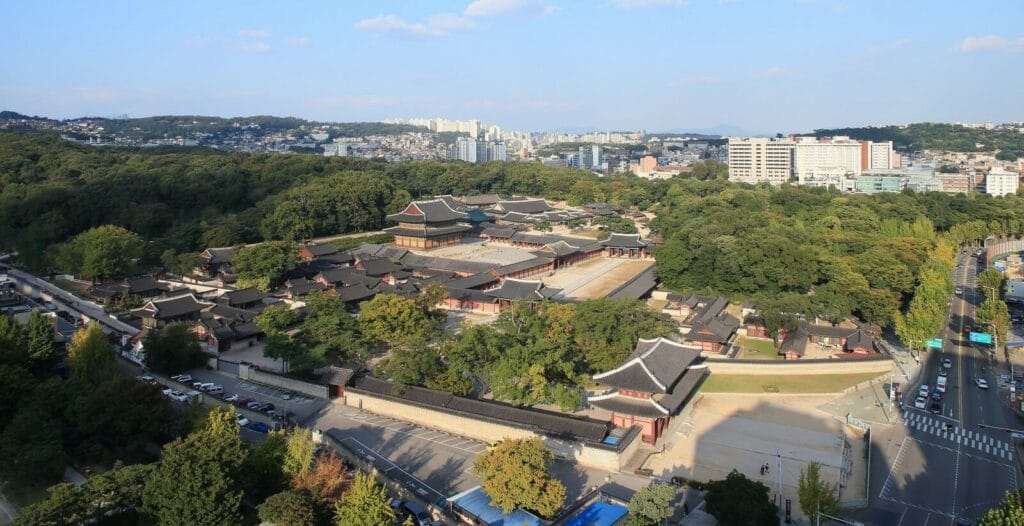
Changdeokgung Palace: The Most Beautiful Secret Garden
To fully experience Seoul’s imperial history, a visit to Changdeokgung Palace is a must. As one of the “Five Grand Palaces” built by the Joseon dynasty, Changdeokgung Palace is recognized as a UNESCO World Heritage Site for its well-preserved architecture and magnificent gardens.
Constructed in 1395, Changdeokgung Palace served as the main royal residence for over 260 years. The palace grounds feature ornate gates, throne halls, and administrative buildings. However, the highlight is undoubtedly the Secret Garden – a 78-acre preserve only open for guided tours. Meandering paths lead you through beautifully manicured lawns, picturesque ponds, and delicate pavilions. In the spring, the garden comes alive with blossoming cherry blossoms and azaleas.
To visit the Secret Garden, you must join one of the guided tours that run at 10 am, 11 am, 2 pm and 3 pm. Tickets can be purchased on-site, but spaces fill up quickly, especially during peak season. It is highly recommended to book tickets in advance through the palace’s official website.
Changdeokgung Palace offers a glimpse into the opulence and splendor of Korea’s Joseon dynasty. A stroll through the palace grounds transports you back in time, while the Secret Garden provides a peaceful escape from the bustle of modern Seoul. No trip to the South Korean capital is complete without exploring this historic landmark.
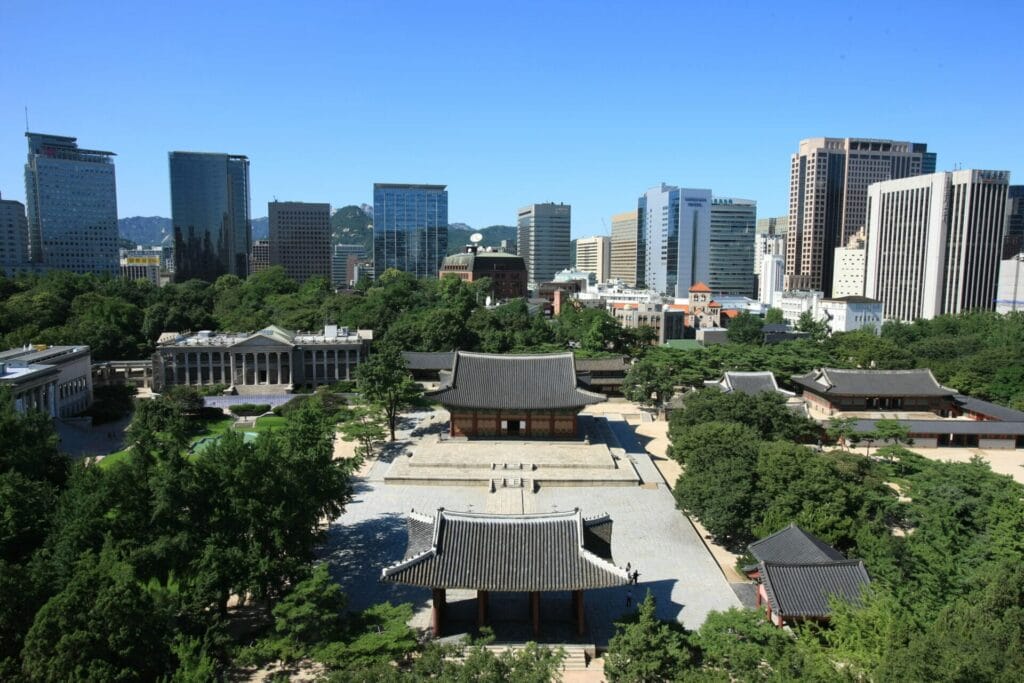
Deoksugung Palace: Where Ancient Meets Modern
Deoksugung Palace is one of the finest examples of Joseon dynasty architecture in Seoul. As one of the “Five Grand Palaces” built by the Joseon dynasty, Deoksugung incorporates both traditional Korean and Western-style buildings within its walls.
Ancient Architecture
The ancient stone walls surrounding Deoksugung Palace were built in the 14th century. Within the palace grounds, Daehanmun Gate and Geunjeongjeon Hall are two of the oldest surviving wooden structures in Seoul, built in the 14th and 15th centuries respectively. Geunjeongjeon Hall in particular is renowned for its double-tiered roof and floor heating system.
A Blend of East and West
In 1897, Deoksugung Palace became the main royal residence. During this period, King Gojong oversaw the construction of Western-style buildings within the palace walls. The contrast between the traditional Korean and Neoclassical architecture is striking yet harmonious. Some of the Western-style halls include Seokjojeon Hall and Junghwajeon Hall.
A Window Into Royal Life
Deoksugung Palace offers visitors a glimpse into the lavish lives of Joseon royalty. The changing of the guards ceremony, held three times daily in front of Daehanmun Gate, is a dramatic reenactment of a 19th-century royal procession. The National Museum of Modern and Contemporary Art located within Deoksugung Palace showcases artworks from the 20th century to the present day, including many works by prominent Korean artists.
With its blend of ancient and modern architecture set against the backdrop of Seoul’s skyscrapers, Deoksugung Palace provides a fascinating insight into Korea’s imperial history and path towards modernization. No trip to Seoul is complete without a visit to this magnificent royal palace.

Bukchon Hanok Village: Historic Korean Houses Come to Life
Discover Seoul’s historic heart at Bukchon Hanok Village, where hundreds of traditional Korean houses called ‘hanok’ are preserved. This urban village in the city center has been inhabited for over 600 years, allowing you to experience the traditional architecture and culture of the Joseon Dynasty.
Bukchon Hanok Village is home to over 900 hanok houses with tiled roofs, stone walls, and heated floors, many of which are still residential homes. As you stroll the picturesque streets and alleyways, you’ll get a glimpse into traditional Korean life. Some hanok houses have been converted into cultural centers, guesthouses, restaurants and teahouses, allowing visitors to appreciate their beauty up close.
The village is located between Gyeongbokgung Palace and Changdeokgung Palace, two of Seoul’s grandest royal palaces. Climbing up to the highest points of the hilly village offers panoramic views of these historic landmarks with a sea of hanok rooftops in the foreground. The scenic setting makes Bukchon Hanok Village an ideal spot for photos.
To explore the village, start from either Anguk Station or Gyeongbokgung Station, then get lost wandering the winding paths. Some highlights include:
- Gahoe-dong – The most scenic area with many well-preserved hanok.
- Hanjeongmok Trail – A historic stone path connecting palaces.
- Bukchon Hanok Village Center – Exhibitions on hanok architecture and culture.
- Some Seon Center – A Zen Buddhist temple and one of the oldest hanok.
- Hanok Guesthouses – Many offer cultural experiences like tea ceremonies, calligraphy and pottery making.
As Seoul modernizes at a rapid pace, Bukchon Hanok Village remains an oasis of tradition in the city. Spending time strolling the picturesque streets of this historic enclave allows you to experience the charm of ancient Korea amidst the bustle of the modern capital. No trip to Seoul is complete without visiting this treasured time capsule.
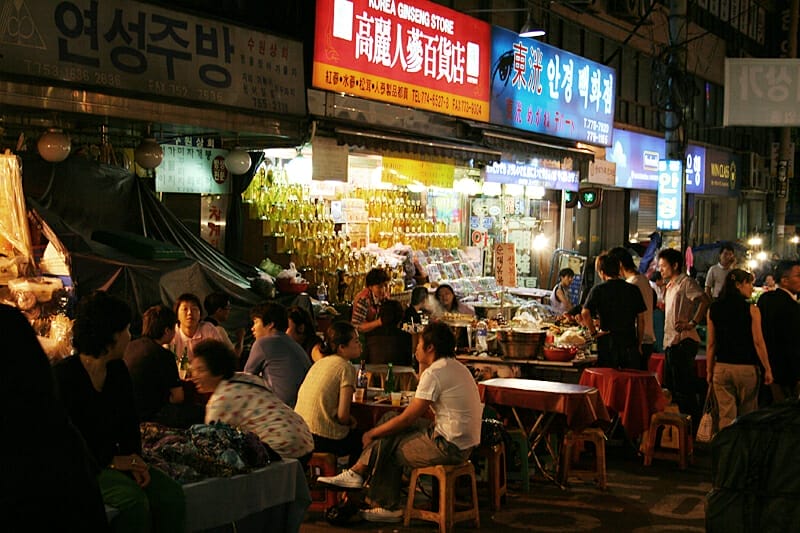
Namdaemun Market: Seoul’s Largest and Liveliest Market
Namdaemun Market, located in central Seoul, is the city’s largest traditional market. Open since 1414, it offers shoppers a glimpse into Seoul’s imperial past and a chance to experience traditional Korean culture. With over 10,000 shops and vendors spread over 66 acres, it is a prime spot to purchase anything from fresh produce and seafood to clothing, crafts, and kitchenware.
A Historic Site
Namdaemun Market is situated next to Namdaemun, Seoul’s oldest stone fortress gate. Constructed in 1398, the gate was an important part of the city’s original walls. The market grew up around this historic gate, with vendors first setting up shops in the early 15th century. Today, the market contains many buildings that date back to the early 20th century, preserving its historic character.
Find Traditional Goods
At Namdaemun Market, shoppers can find a wide array of traditional Korean goods. From hanbok, the colorful traditional dress, to handcrafted lacquerware boxes, there are many options for those seeking unique souvenirs. The market is also known for high-quality ginseng, teas, and other traditional medicinal herbs. For cooks, the market offers all the ingredients needed to make classic Korean dishes like kimchi, bibimbap, and bulgogi.
Bargain and Experience Seoul’s Culture
The bustling alleys of Namdaemun Market provide an immersive experience of traditional Seoul culture. Shoppers are expected to bargain with vendors to get the best deals. Prices are often significantly lower than in regular stores. In between shopping, stop for some street food like hotteok (sweet pancakes) or mandu (dumplings). Or sit down for a meal of naengmyeon, cold buckwheat noodles, or samgyetang, ginseng chicken soup. Observe elderly shoppers examining the produce and seafood for the freshest ingredients, or young people searching for the latest K-pop fashion trends.
Namdaemun Market offers visitors a glimpse into Seoul’s vibrant culture, history, and daily life. No trip to the South Korean capital is complete without exploring this legendary market. Wandering its maze of alleys, you’ll find everything from ancient traditions to modern trends on display.
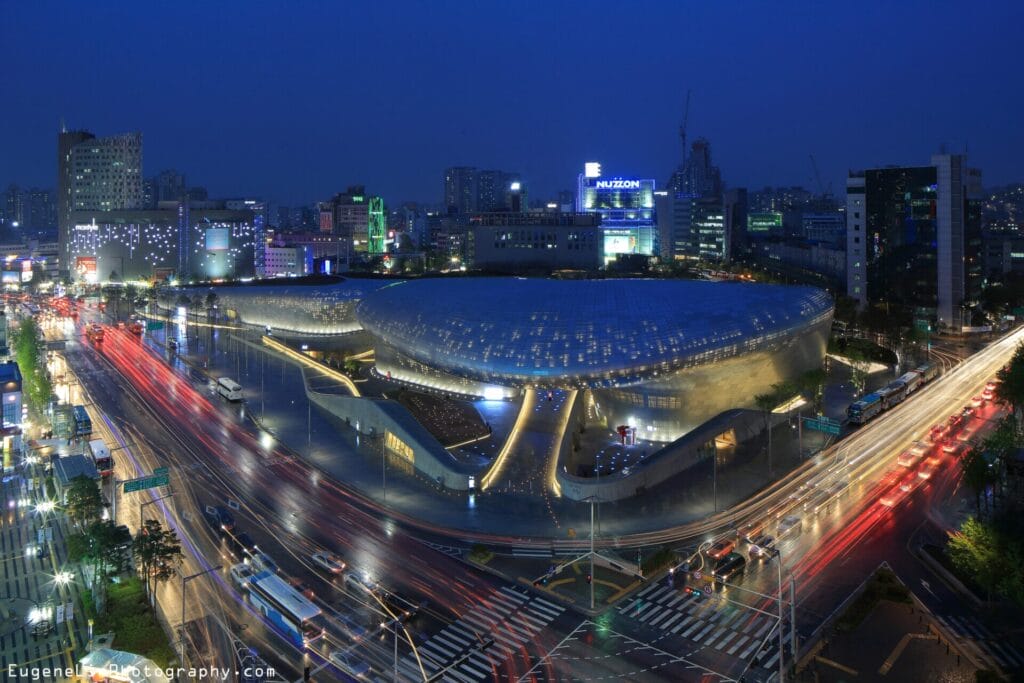
Dongdaemun Design Plaza: Iconic Architecture and Design
The Dongdaemun Design Plaza is a futuristic complex in downtown Seoul housing galleries, event spaces, and a design market. Designed by world-renowned architect Zaha Hadid, the DDP is a striking example of contemporary architecture.
Exterior
The DDP’s curvilinear metallic facade resembles a spaceship. Its aluminum panels reflect the surrounding cityscape by day and glow at night when lit. The building’s fluid forms contrast with the boxy high-rises surrounding it, making it an iconic part of Seoul’s skyline.
Interior
The interior is just as striking. An undulating walkway guides visitors through cavernous event halls and galleries. The DDP houses cultural facilities like the Seoul Design Foundation and Dongdaemun History and Culture Park. It hosts design fairs, exhibitions, and other cultural events promoting Korean design.
Location
The DDP is located in Dongdaemun, a historic commercial district. It sits on the former site of Dongdaemun Stadium, built in 1925 during Japanese rule. The DDP aims to fuse Korea’s design heritage with its modernity and revive the area as a hub for fashion and design. It is adjacent to sprawling markets like Dongdaemun Market, a popular shopping area for clothing, fabrics, and crafts.
Impact
Since opening in 2014, the DDP has become an iconic symbol of Seoul. Its futuristic design contrasts with the palaces and temples the city is known for, representing Korea’s ambition to become a global leader in design and technology. The DDP attracts design enthusiasts and tourists interested in Seoul’s contemporary culture. Along with facilities like the Seoul Design Foundation, it aims to foster Korean designers and promote design as a cultural industry.
The DDP is a striking example of 21st-century architecture and an important center for design in Seoul. Exploring its galleries and events offers insight into the future of Korean design and culture. No trip to Seoul is complete without seeing this iconic building.
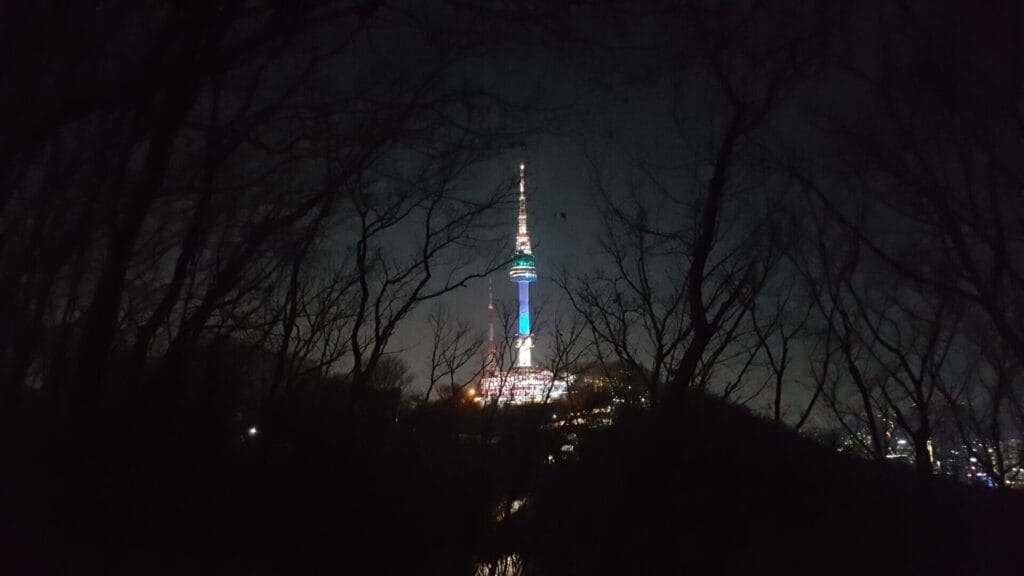
Namsan Tower: Stunning City Views
Namsan Tower, also known as N Seoul Tower, is one of the most iconic landmarks in Seoul. At 480 feet high, it offers panoramic views of the city from its observation deck.
Getting There
The tower is located on Namsan Mountain in central Seoul. The easiest way to reach it is to take a cable car up the mountain. Cable cars depart from the base of the tower and Myeongdong Station. For a more scenic journey, you can hike up one of the many walking trails that start from Namsan Tunnel 3 or Seoul City Hall.
Once at the top, head to the tower’s observation deck. On a clear day, you’ll be rewarded with stunning 360 degree views of Seoul’s modern skyline, including the Hangang River and Bukhansan National Park. As night falls, thousands of lights illuminate the city, creating a dazzling sea of neon. The tower itself is also illuminated, making it a iconic part of Seoul’s nighttime cityscape.
In addition to the observtion deck, the tower complex contains gift shops, restaurants, and an digital observatory. The digital observatory showcases Seoul’s history and culture through virtual reality and multimedia exhibits. There is also a teddy bear museum, Seoul Tower Plaza, and the Hancook restaurant which serves traditional Korean cuisine while spinning to offer panoramic views.
A visit to Namsan Tower is essential to understanding why Seoul is known as “the soul of Asia.” Gazing out at the city from this historic landmark, you’ll begin to comprehend the mix of ancient and modern that gives Seoul its unique character. You’ll gain insight into how far South Korea has progressed into a global economic powerhouse with a vibrant culture.
Namsan Tower reigns over Seoul both day and night, a symbol of the city’s indomitable spirit. No trip to the South Korean capital is complete without ascending to its peak.

Cheonggyecheon Stream: An Oasis in the City
The Cheonggyecheon Stream is an oasis of natural beauty amidst the bustle of downtown Seoul. Restored in 2005, this 5.8 km creek flows through the heart of the city, offering respite from the surrounding skyscrapers and traffic.
A Place of History
For over 600 years, Cheonggyecheon Stream played an important role in the daily lives of Seoul residents. During the Joseon Dynasty, the stream was used for transportation, trade, and agriculture. Sadly, as Seoul modernized, the stream became polluted and was eventually paved over. The restoration project uncovered the stream beneath the expressway and revived it as a cultural landmark.
A Natural Escape
The Cheonggyecheon Stream provides a serene natural space in the city center. Lined with pathways, gardens, and art installations, the stream attracts locals and tourists alike seeking fresh air and greenery. Over 22,000 fish and several bird species now inhabit the stream, a testament to the successful restoration of biodiversity. Visitors can enjoy walking or cycling along the paths, watching wildlife, or simply sitting quietly.
A Place to Learn
Informative placards share the history of the Cheonggyecheon Stream. Visitors can learn about its important role in Seoul’s development, past ecosystems, and the extensive restoration process. The stream is also home to the Cheonggyecheon Museum, documenting its transformation and environmental significance.
The Cheonggyecheon Stream restoration demonstrates how nature and culture can coexist in harmony even in a bustling modern city. By uncovering a piece of living history, the project gave Seoul back an important part of its identity and provided an oasis of calm amid the chaos of everyday life. No visit to Seoul is complete without spending time strolling along its serene banks.

Jogyesa Temple: Find Zen in Seoul
One of the most important places to understand Seoul’s Buddhist history is Jogyesa Temple. As the head temple of the Jogye Order of Korean Buddhism, Jogyesa Temple gives visitors insight into how Buddhism shaped Korean culture.
When you enter the temple grounds, the first thing you’ll notice is the elegant stone pagoda. Built in 1938, this pagoda displays the temple’s long history. Next, head to Daeungjeon, the main hall. Inside, a massive golden Buddha statue sits atop an intricately carved lotus flower. This figure represents purity of body, speech and mind.
Around the main hall are multiple smaller buildings used for meditation, lectures and ceremonies. If you time your visit right, you may witness monks chanting sutras or participating in rituals. The sounds of drums, bells and chanting fill the air.
The temple also has well-manicured gardens, ponds and walking paths. Stroll through and you’ll find numerous smaller shrines and statues honoring Buddhist deities and philosophers. The gardens are especially stunning in spring when the cherry blossoms are in bloom or fall when the foliage changes color.
An essential part of any visit is observing the monks who study and live at the temple. You may see them going about daily tasks like preparing meals, cleaning, or meditating. Their serene and disciplined way of life serves as an example of Buddhist teachings in action.
Jogyesa Temple provides a tranquil oasis in the bustling city. Wandering the grounds, you’ll gain insight into core Buddhist principles of mindfulness, simplicity and harmony with nature. Although centuries old, the temple remains highly relevant and continues to shape Korean cultural identity. A visit here allows you to discover a bit of Seoul’s soul.
As you wander the halls of Seoul’s grandest palaces and temples, the city’s imperial history comes alive. At Gyeongbokgung Palace, the changing of the guard ceremony transports you to the Joseon era as guards patrol the ancient stone paths. At Changdeokgung Palace, the Secret Garden’s ponds and pavilions offer a glimpse into the lives of past royalty. And at Jogyesa Temple, the rhythmic chanting of Buddhist monks echoes through the wooden temple halls, a reminder of Korea’s deep spiritual roots.
Seoul’s imperial sites showcase the city’s beauty, resilience, and enduring spirit. Though dynasties have risen and fallen, these places stand as a testament to Seoul’s noble and unforgettable past. A visit to the city’s most majestic monuments connects you with centuries of history in a profound and memorable way.

